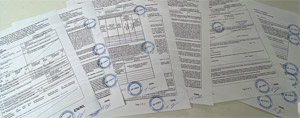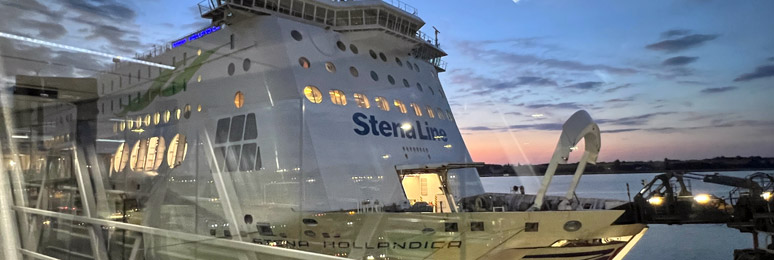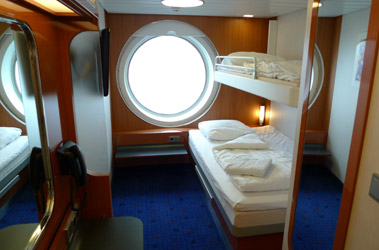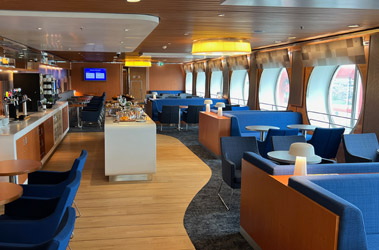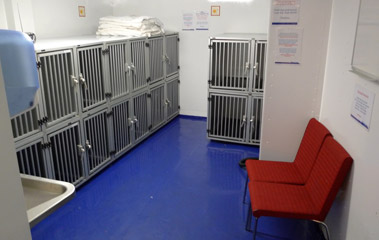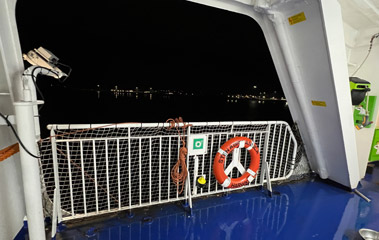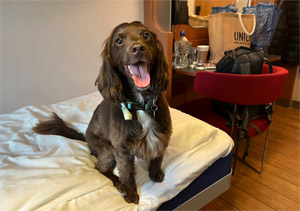 Pip sharing our pet-friendly cabin on the Harwich-Hoek van Holland ferry. Pet travel: see www.gov.uk/guidance/pet-travel-to-europe-after-brexit.
The £180 10-page pet health certificate, with more stamps than a 1970s Soviet visa. Another Brexit dividend, as the UK is no longer a member of the Pet Passport scheme. |
How to take your dog by train
This gets asked surprisingly often, as it's difficult and expensive to send dogs, cats or other pets by air, and pets find it very stressful alone in the hold of a plane. So why not take your dog by train or ferry, the civilised and comfortable option? Unfortunately Eurostar doesn't allow dogs on trains to/from London, except guide dogs. But there are alternatives - this page explains the options for civilised & enjoyable train & ferry travel between the UK and European destinations with your dog, cat or other pet.
![]() Step 1, taking your dog on trains in the UK
Step 1, taking your dog on trains in the UK
![]() Step 2, getting your
dog across the
Channel
Step 2, getting your
dog across the
Channel
![]() Step 3, taking dogs on trains
in mainland
Europe
Step 3, taking dogs on trains
in mainland
Europe
Microchip, vaccinations, health certificate
Before you start, you'll need to make sure your dog or pet is fitted with a microchip and has an up-to-date rabies vaccination. Call your vet, they can advise you.
To take a pet from the UK to the EU, see your vet no more than 10 days before you travel for a simple health check and to get a health certificate. Expect this to cost £180 (yet another a Brexit cost as the UK is no longer a member of the Pet Passport scheme). The certificate is a 10-page document with more stamps than a 1970s Soviet transit visa which allows you to take your pet into the EU for up to 4 months and to re-enter the UK within 4 months. You can have more than one pet on the same health certificate. For certain countries you'll also need a tapeworm treatment, including Ireland, Northern Ireland, Norway, Finland & Malta.
A day or two before you return to the UK, make a vet's appointment. The vet gives your dog a tapeworm tablet and fills in/stamps the relevant section on the form. This must be done no less than 24 hours and no more than 120 hours (5 days) before you enter Great Britain. Expect this to cost around €40. This allows you to return to the UK.
For full details on how to take a pet abroad, see www.gov.uk/guidance/pet-travel-to-europe-after-brexit.
For full details on how to bring a pet into the UK, see www.defra.gov.uk/wildlife-pets/pets/travel.
Tip: As you can't take meat or dairy products into the EU, only take enough regular pet food for the Channel crossing. Take kibble for the onward journey, or stock up with wet food once on the Continent.
Step 1, taking a pet on British trains
This bit is easy. You can take dogs, cats and other small animals free of charge on all British trains, up to a maximum of two per passenger, as long as they don't endanger or inconvenience passengers or staff. Dogs must be kept on a lead unless inside a carrier. Dogs without leads, cats, birds and small animals must be carried in an enclosed cage or pet carrier which must be rigid and not open (to prevent escape) and the animal able to stand and lie down in comfort. Animals and containers must not occupy seats or a charge may be made. If you want to use a Caledonian Sleeper to or from Scotland, you'll need to pay a fee, see here. For full details of dog & pet regulations on British trains see www.nationalrail.co.uk/on-the-train/train-travel-with-pets. So far, so good.
Step 2, getting across the Channel
Let's get the biggest problem out of the way first: Eurostar doesn't carry dogs or pets on trains between London & mainland Europe, except guide dogs. And most ferry operators won't let foot passengers take dogs either. In fact, there are only three ferry operators who let foot passengers take dogs:
Stena Line Harwich-Hoek van Holland, P&O Hull-Rotterdam, DFDS Newhaven-Dieppe & DFDS Newcastle-Amsterdam.
You could of course dress your dog as a guide dog, pretend to be blind, and take Eurostar. I'm only half joking as the Eurostar journey would be so simple compared to some of the other options, though I must admit I haven't heard from anyone who has tried it. Difficult to be convincing if your dog is a Yorkshire Terrier (unless he's a really good actor). Realistically, here are the options for crossing the Channel with your dog or other pet:
![]() Option 1, by ferry Harwich-Hoek van
Holland
Option 1, by ferry Harwich-Hoek van
Holland
![]() Option 2, by
ferry Newhaven-Dieppe
Option 2, by
ferry Newhaven-Dieppe
![]() Option 3, Pet Travel Abroad
taxi service
Folkestone-Calais
Option 3, Pet Travel Abroad
taxi service
Folkestone-Calais
![]() Option 4, by ferry from Hull or Newcastle
Option 4, by ferry from Hull or Newcastle
Option 1, London to Holland with Stena Line
I recommend this option for travel with your dog from the UK to the Netherlands, Germany, Austria, Poland, Czechia, Scandinavia and so on.
It's a round-about route to France, Spain, Switzerland & Italy, but because it's so dog-friendly with easy train-to-ferry and ferry-to-train connections either side of the Channel, it's a surprisingly good option even for that. It also avoids the need to stay overnight in Paris because you can sail to Hoek overnight in a pet-friendly cabin, then catch a morning high-speed train to Paris, then take an afternoon TGV from Paris to Nice, Barcelona, Switzerland or Milan.
What is Stena Line Rail & Sail?
Stena Line Rail & Sail is an integrated train & ferry service between London & the Netherlands run jointly by Greater Anglia & Stena Line. One ticket covers the whole journey from London or any East Anglia rail station to Hoek van Holland. It works in both directions, but I'll describe the outward journey here.
You take the 19:36 train from London Liverpool Street station to Harwich and your dog travels with you on the train.
At Harwich, the train arrives alongside the ferry terminal around 20:59. You walk off the train into the ferry terminal, through passport control (where your dog or cat's pet passport will be checked) and onto the luxurious Stena Line superferry to Hoek van Holland. You enter the ship via the passenger gangway onto deck 7.
If you've booked a pet-friendly cabin, take your dog or cat by lift or stairs up to deck 10, where the pet-friendly cabins are. All cabins have a shower, toilet, WiFi and satellite TV. Your pet stays with you in the cabin, they're not allowed in the rest of the ship. If your pet needs a pee or poo, go down the Red Stairs to deck 7 to the small outside deck area where they can get some air, have a little exercise and do their business. Inevitably, we refer to this as the poop deck.
If you've booked a kennel, take your dog up two decks by lift or stairs to the Guest Services desk on deck 9, this is the main passenger deck with bars, lounges & restaurant. Guest Services will give you a kennel number in Kennel A or Kennel B and give you the 4-digit access code for the kennels. You then go down one deck on Red Stairs to the kennels on deck 8. The kennels have a washbasin, they provide blankets for dogs to sleep on, but take your pet's water bowl, food bowl and favourite toy. If your pet needs a pee or poo, go down one deck to deck 7 to the small outside deck area where they can get some air, have a little exercise and do their business.
After putting your pet into their kennel you can settle in to your private cabin on deck 10 or 11 and perhaps have dinner in the restaurant or Stena Plus lounge on deck 9. All cabins have a shower, toilet, WiFi and satellite TV. Channel 6 on the TV shows CCTV pictures of the kennels with close-ups of the cages. You can visit your dog any time during the crossing, although pets are not allowed in the public areas other than to reach Customer Services or a pet-friendly cabin.
The ferry sails at 23:00 every day and arrives at Hoek van Holland at 08:00 next morning, Dutch time.
You collect your dog from the kennels, if they need a pee you can take them to the small outside deck area on deck 7. You walk off the ferry into the terminal and out to the adjacent metro station for the frequent metro train to Schiedam & Rotterdam. Dogs go free on the RET metro. You can use any contactless bank card to travel, just touch in and out at the start and end of the metro journey.
Get off the metro in Schiedam Centrum for a frequent NS (Dutch Railways) InterCity train to Amsterdam, arriving Amsterdam Centraal around 10:25. In the reverse direction, you'd leave Amsterdam Centraal around 18:35, the ferry sails from Hoek around 22:00 arriving Harwich at 06:30, you reach central London around 08:55.
Or continue to Eendrachtsplein station in Rotterdam city centre, from where it's then an 800m 10-minute walk to Rotterdam Centraal. Or continue to Rotterdam Alexander for NS trains to Utrecht, Groningen and so on.
You'll find details, photos & a video guide on the Stena Line Rail & Sail page.
Onward trains to Germany, Austria, Switzerland, Italy, Eastern Europe etc...
Direct daytime trains link Amsterdam with Germany & Switzerland - in many cases these go via Utrecht, changing at Utrecht saves going all the way to Amsterdam. Regular daytime trains link Rotterdam with Brussels & Paris. All these trains take dogs, sometimes free, sometimes for a fee.
Or take the Nightjet sleeper from Amsterdam to Basel, Zurich (change for Italy), Munich, Innsbruck or Vienna (change for Bratislava, Budapest, Zagreb), dogs are carried on Nightjets as long as you and your party occupy a whole compartment.
You'll find specific timetables for journeys between London and each of the following countries here: Belgium, Italy, Switzerland, Germany, Austria, Denmark, Hungary, Czech Republic & Poland.
Onward trains to Paris (for France, Switzerland, Spain, Italy)
Take the metro from Hoek van Holland to Eendrachtsplein station in Rotterdam, dogs go free on the metro. It's then an 800m 10-minute walk to Rotterdam Centraal.
Then take a Eurostar (formerly Thalys) high-speed train from Rotterdam Centraal to Paris Gare du Nord, you'll usually find a 10:58 arriving 13:38. Dogs can travel in any class on Eurostar (formerly Thalys) trains for €30, you pay the dog fee on board to the conductor. Book your own ticket from Rotterdam to Paris from €35 online in advance at www.sncf-connect.com (don't bother trying to add a dog to the booking, this doesn't work with Eurostar (formerly Thalys).
How much does it cost?
For times & fares between London and the following countries, click on your destination country: Netherlands, Belgium, Italy, Switzerland, Germany, Austria, Denmark, Hungary, Czech Republic & Poland.
On the train from London to Harwich your dog travels free.
On the ferry, you must reserve a kennel (£23) or a book pet-friendly cabin.
On the RET metro from Hoek to Schiedam or Rotterdam, dogs travels free.
On the Dutch domestic trains from Schiedam or Rotterdam to Amsterdam & Utrecht, small dogs or cats in containers on your lap travel free, but a larger dog requires a dog day-ticket (Dagkaart Hond) for €3.50, see www.ns.nl/en/tickets/day-ticket-dog.
On the international daytime trains from Amsterdam or Utrecht to Germany and Switzerland, cats and small dogs (up to cat sized) in containers travel for free, larger dogs on leads travel for a fee.
On the Nightjet sleeper trains from Amsterdam to Basel, Zurich, Munich, Innsbruck & Vienna, dogs are carried for €29 paid on board the train, as long as you and your party occupy a whole compartment.
How to buy tickets
Step 1, book your Rail & Sail ticket from London to Hoek van Holland at www.stenaline.co.uk.
To travel with a dog or car, you simply need to choose a pet-friendly (animal) cabin at the cabin stage then select Pet in cabin at the extras stage, or add a Pet in kennel at the extras stage.
Note that www.stenaline.co.uk can only book one-way or return tickets starting in the UK. One-way or return tickets starting in the Netherlands must be booked at Stena Line's Dutch website, see the advice here.
Step 2, you can pay for the RET metro from Hoek to Schiedam or Rotterdam with a contactless card, dogs go free.
Step 3, if going to a Dutch destination or picking up a Nightjet sleeper train in Amsterdam: First buy a ticket for yourself from Schiedam or Rotterdam to anywhere in the Netherlands at www.ns.nl. Then buy a dog day ticket at www.ns.nl/en/tickets/day-ticket-dog (please let me know if that link stops working).
Step 3, if using daytime travel to Germany, Austria, Denmark, Switzerland and so on, book from Schiedam Centrum or Rotterdam Alexander to your destination at int.bahn.de. Small (cat-size) dogs & cats in containers go free, if you have a larger larger dog you can add it to the booking.
Step 3 if using a Nightjet sleeper train from Amsterdam to Basel, Zurich, Munich, Innsbruck or Vienna, book this at Austrian Railways www.oebb.at. You pay for the dog on board.
The Stena Hollandica boarding at Harwich, a floating hotel with private cabins, restaurant, bar, lounges, shop & kennels. More about the journey.
Above left, standard outside cabin. Larger photo. 360º photo. All cabins have satellite TV, channel 6 cycles through wide and close-up shots of all the kennel cages, so you can see that your pet is OK.
Above right, the Stena Plus lounge with complimentary red & white wine, tea, coffee & snacks.
Above left, one of the two kennels. Kennels A & B are located on Red Stairs on deck 8, just below the main passenger deck (deck 9) & cabin decks (10 & 11). The door has a 4-digit security code lock so only pet owners can enter. The kennels have large and small cages and a washbasin. A dog mattress is provided.
Above right, the 'poop deck' on deck 7, down the red stairs.
Option 2, London to Paris via the Newhaven-Dieppe ferry
See the London/Brighton-Newhaven-Dieppe-Paris timetable on the London-Paris by train & ferry page. This is the cheapest option if you're heading for France or Spain.
Step 1, take a train to Newhaven Town, see www.nationalrail.co.uk for train times.
Up to 2 dogs of any size go free of charge on British trains, just buy a ticket for yourself.
Step 2, take a DFDS ferry from Newhaven to Dieppe, check ferry times at www.dfds.com.
DFDS allows you to take a cat or dog with you as a foot passenger on these routes.
Only small and medium size dogs are carried, according to DFDS customer services. That means I'd expect them to have no problem with springer spaniels, but they won't carry great Danes or St Bernards. You'll have to call them to check whether your labrador will fit their kennels.
If the animal is small and in a carrier, the pet & carrier are handed to staff at check-in and returned to you after the crossing. Larger dogs have to be booked in one of the ship's 3 kennels, although you can visit the pet in the middle of the crossing by taking an appointment at the reception desk.
To book as a foot passenger with a pet you must call DFDS on 033 058 787 87 if you're in the UK or 0809 541 890 if you're in France or +44 33 058 787 87 from outside either country. You cannot book online if you're taking a pet!
Step 3, take a French train from Dieppe to Paris St Lazare, book this at www.sncf-connect.com.
Dogs can be taken on all French trains. Small dogs (under 6Kg) placed in containers not exceeding 45cm x 30cm x 25cm pay no more than €5.10 per journey. Larger dogs muzzled and on leads pay half the 2nd class full fare (even travelling in 1st class).
You can buy a ticket in English at the official French Railways website www.sncf-connect.com (for English scroll to the bottom and change France to Europe (other countries). You add a dog to the booking by clicking the Add button (English version) or Ajouter (French version) before running the enquiry.
Once in Paris, you can take onward trains to Spain, Portugal or the South of France, as shown in step 3 below.
Traveller Juan Alfredo Picasso reports (2025): "The train to Newhaven Town was very straightforward and it's only a short walk from there to the DFDS check-in building. Dog documentation was quickly checked and my dog's microchip was scanned for a match. Once you step into the ferry, someone asks you to follow them to the Kennels. They are pretty basic and cage-like, but I had my dog's bed with me which made it tons better. The ferry crossing was comfortable and the DFDS restaurant food good. You can ask someone at the ship's reception if you want to go and check on your dog. They ask you to come back at a certain time and they take all dog owners at once below deck. Once you arrive in Dieppe, you go through migration and they didn't even ask for any papers for my dog, so was very straightforward. There's a bus that takes you to the train station and you're allowed to hop on with the dog, which was great. The train to Paris was comfortable, with a change in Rouen. Dog had to wear a muzzle at all times, which they absolutely hated but it was fine."
Option 3, London to Paris by train + taxi with Pet Travel Abroad.
For France, Spain or Portugal you really need to go via Paris. As Eurostar won't take pets and most Channel Ferries won't let foot passengers take pets either, here is a solution which works well, although it's not cheap:
Step 1, travel from London to Folkestone by train.
You can use any normal British domestic train, dogs go free. There are hourly or half hourly trains from London Charing Cross, Waterloo East or St Pancras to Folkestone Central, check train times & fares at www.nationalrail.co.uk.
Step 2, book a taxi from Folkestone to Calais via the Eurotunnel shuttle with Pet Travel Abroad.
Book your trip by calling Pet Travel Abroad (part of Folkestone Taxis) on 01303 246 925 (+00 44 1303 246925 from outside the UK), see their pet transport page at pettravelabroad.co.uk.
They can take you and your dog and up to 3 other passengers from Folkestone Central station to Calais Ville or Calais Fréthun stations for around £190 plus the cost of the Eurotunnel ticket, typically £164, but this can vary.
You and your dog remain together in the taxi throughout the journey via the Channel Tunnel car shuttle train. Pet Travel Abroad (part of Folkestone Taxis) has been highly recommended by several travellers, further feedback is always appreciated.
Of course, a cheaper solution is to get a friend to drive you to Calais and drop you at the station, using a cheap day return ferry ticket - try www.dfds.com or www.poferries.com. The dog remains inside the car on the ferry car deck.
Step 3, take a French domestic train from Calais Ville or Calais Fréthun to Paris.
To check train times use www.sncf-connect.com, this lets you add a dog to the booking. On French trains, small dogs under 6 Kg placed in containers not exceeding 45cm x 30cm x 25cm pay no more than €5.10 per journey. Larger dogs muzzled and on leads pay half the 2nd class full fare, even travelling in 1st class. For onward train travel with your dog to Spain, Italy, Portugal and so on, see the following section.
How to plan your trip.
The French trains from Calais to Paris are irregular and less frequent than the British ones, so start by picking a suitable afternoon train from Calais to Paris and work backwards. Ask Folkestone Taxis what time you need to leave Folkestone Central in their taxi to make this train. Then work out a train from London (or your local station) to Folkestone Central with plenty of time in hand.
You can buy a ticket in English at the official French Railways website www.sncf-connect.com (for English scroll to the bottom and change France to Europe (other countries). You add a dog to the booking by clicking the Add button (English version) or Ajouter (French version) before running the enquiry.
This blog may inspire you: Argo, the dog who took the train to Italy.
Option 4, Hull-Rotterdam or Newcastle-Amsterdam by ferry
You can take a dog as a foot passenger on P&O Ferries Hull-Rotterdam route, with pet-friendly cabins & kennels. Book online and add a pet plus pet-friendly cabin or kennel at www.poferries.com. More about the Hull-Rotterdam ferry route.
You can also take a dog as a foot passenger with pet-friendly cabins on DFDS overnight Newcastle-Amsterdam ferry. However, you can't book online as a foot passenger with a pet, you need to book by phone, so check sailing times at www.dfds.com then call DFDS on 0871 522 9955. More about the Newcastle to Amsterdam ferry route.
Step 3, taking pets on trains in mainland Europe
Once safely across the Channel, you can take a dog or cat with you on most trains across Europe, sometimes free, sometimes for a small charge, sometimes with a normal child-rate ticket. In sleeping-cars and couchettes on overnight trains, you can generally only take a dog if your party occupies all the berths in a compartment. For simplicity I'll assume you're going outbound from the UK, but the journey and booking process work just the same in either direction.
![]() Hungary, Poland, Romania
& central Europe
Hungary, Poland, Romania
& central Europe
To France
-
From the UK to France
Eurostar doesn't take dogs and nor do most ferry companies unless you are a motorist. P&O Dover-Calais used to allow foot passengers to take dogs, but have stopped doing in 2012. However, DFDS let foot passengers take caged pets on their Newhaven-Dieppe route.
So either travel from London to Paris using a train to Newhaven, DFDS ferry to Dieppe, taxi to the station and train to Paris as explained in option 2 above, OR travel from London to Paris by train to Folkestone, Folkestone Taxis through the Tunnel from Folkestone Central to Calais Ville, then train to Paris as explained in option 3 above.
Or you can travel from the UK to Paris via Hoek van Holland using option 1. It's a round-about route, but so easy, dog-friendly, inexpensive and avoids the need for an overnight stop in Paris as you can sail overnight from Harwich to Hoek van Holland in a cosy pet-friendly cabin, catch the metro to Rotterdam and a morning high-speed train to Paris, then take an afternoon train to almost anywhere in France, even Nice & the south coast.
-
Pets on trains within France
Dogs can be taken on all French trains. Small dogs (under 6 Kg) placed in containers not exceeding 45cm x 30cm x 25cm pay €7 per journey. Larger dogs muzzled and on a lead pay €7.
You can buy a ticket in English at the official French Railways website www.sncf-connect.com, you add a dog to your booking by clicking the Add travellers, pets & bicycles button before running the enquiry.
To the Netherlands
-
From the UK to the Netherlands
I recommend travelling via the Harwich-Hoek van Holland superferry as shown in option 1 above. Once at Hoek van Holland your Dutch Flyer ticket is valid to any Dutch station, not just Amsterdam. You can book from London to Amsterdam or any Dutch station online at www.stenaline.co.uk, adding a kennel during the booking process.
Alternatively, you can also take a dog as a foot passenger with pet-friendly cabins on DFDS overnight Newcastle-Amsterdam ferry, but you must book by phone, check sailing times at www.dfds.com then call 0871 522 9955. P&O take dogs with foot passengers on their overnight Hull-Rotterdam ferry, see www.poferries.com.
-
Pets on trains within the Netherlands
On Dutch trains, small dogs or cats in containers placed on your lap travel free of charge, if you have a larger dog on a lead you will need to buy a Dagkaart Hond (dog day-ticket) for just over €3. You can check details for this at the Dutch Railways site www.ns.nl.
To Switzerland
-
From the UK to Switzerland
I'd go via Hoek van Holland, for details of London to Switzerland via Harwich-Hoek see the Switzerland page.
Step 1, take the train & ferry service from London to Utrecht or Amsterdam via the Harwich-Hoek van Holland ferry, as explained in option 1 above. You book from London to Hoek van Holland at www.stenaline.co.uk, adding a reserved kennel during the booking process.
Step 2, travel from Utrecht or Amsterdam to anywhere in Switzerland. Book this at the German Railways website int.bahn.de.
Small dogs and cats in containers go free, larger dogs not in a carrier travel for a fee.
To add a larger dog to the booking, click the From field to open the details panel, click on Passenger, bicycles, BahnCards, click on Add travellers, bicycles, dogs and add your dog.
-
Pets on trains within Switzerland
Dogs of any size can travel for half the 2nd class fare on any Swiss train (for longer journeys there's a Dog Day card), small dogs up to 30cm high at the shoulder can travel free if they are in a carrier, you'll find information on the Swiss railways website www.sbb.ch and you can easily buy Swiss tickets at the station when you get there.
To Italy
-
From the UK to Italy, via Hoek van Holland
Travel overnight from London to Hoek van Holland using the Harwich-Hoek van Holland ferry as explained in option 1 above.
I'd then suggest travelling from Amsterdam to Munich by daytime trains, then overnight again from Munich to Venice on the excellent Nightjet sleeper train. You'll find full details of these trains and how to book them in the via Harwich section of the London to Italy page.
Dogs travel on the German-run trains between Amsterdam, Cologne & Munich under the same arrangements as for trains within Germany explained in the To Germany section below.
Dogs are carried on the Nightjet sleeper from Cologne to Innsbruck or Vienna for €29, as long as you and your party occupy a whole compartment. You don't need to book the dog, you just pay the extra €29 to the staff on board the train.
First book the London-Amsterdam part of the journey online at www.stenaline.co.uk, adding a reserved kennel during the booking process.
Then book Amsterdam-Munich followed by Munich-Venice using www.thetrainline.com. Then buy a separate 2nd class child ticket for your dog from Amsterdam to Munich as explained in the To Germany section below.
Then travel onwards from Venice to other Italian cities. See the Pets on trains within Italy section below.
Alternatively, you can take daytime trains from Utrecht to Basel or Zurich, book these online at int.bahn.de. Stay overnight in Basel or Zurich. Then take a Zurich to Milan EuroCity train, which you can book online at www.sbb.ch. Dogs under 30cm high at the shoulder in a carrier travel free on this EuroCity train and on onward trains within Italy. Dogs over 30cm high and not in a carrier must have a ticket, usually charged at half the 2nd class fare, which you can buy at the station in Zurich for about £35.
-
From the UK to Italy, via Paris
Step 1, Eurostar doesn't take dogs, so travel from London to Paris via Folkestone/Newhaven & Paris using option 2 or option 3 above, both involving ferry or EuroTunnel to France then domestic French train to Paris. You may need to stay in Paris overnight. Or use option 1 via Hoek van Holland, it's a round-about route, but so easy, dog-friendly, inexpensive and avoids the need for an overnight stop in Paris.
Step 2, you can then take one of the three daily Paris-Turin-Milan TGV trains in 1st or 2nd class with any size of dog muzzled and on a lead for €20, or a small dog/cat in a pet carrier not exceeding 45cm x 30cm x 25cm for €7. You can book yourself and your dog from Paris to Milan at www.sncf-connect.com, look for the Add Travellers, animals, bicycles button and add a dog on a lead or in a carrier before running the enquiry.
Step 3, take an onward train from Milan or Turin to anywhere in Italy, see the Pets on trains within Italy section below.
Dogs are also carried on Trenitalia's competing Paris-Milan Frecciarossa, dogs under 5 Kg go free, dogs 5-50 Kg €30, all dogs must travel in Standard or Business class Allegro cars. See the London to Italy page for details of times, prices and how to buy tickets. The £10 fee for taking a dog on the Paris-Milan TGV must be paid by phone, it cannot be booked online.
-
Pets on trains within Italy
Dogs and pets are carried on most Trenitalia trains, both high-speed and regional.
They travel for free if in a carrier, maximum size 70cm x 30cm x 50cm, maximum one pet carrier per person.
Larger dogs on a lead and muzzled travel for €5 (only €1 on Saturdays). You can book you and your dog online at www.trenitalia.com. When you get to the stage where you enter you name, scroll down past Need anything else for your trip? and click the Travelling with your dog +Add box.
You'll need to carry the dog's pet passport or health certificate, and yes, you will need to use a muzzle if your dog isn't inside a carrier. You aren't allowed to take dogs on certain busy regional trains, as shown in the timetable. You aren't allowed to take a dog in Premium class on Frecciarossa high-speed trains. You can take a dog in sleepers or couchettes, but only if you and any companions occupy the whole compartment.
For full details go to www.trenitalia.com, switch it to English, click Services then Travelling with your pet.
To Spain
-
From the UK to Barcelona, Madrid, Malaga, Valencia, Alicante...
Step 1, Eurostar doesn't take dogs, so travel from London to Paris via Folkestone/Newhaven & Paris using option 2 or option 3 above, both involving ferry or EuroTunnel to France then domestic French train to Paris. You may need to stay in Paris overnight. Or use option 1 via Hoek van Holland, it's a round-about route, but so easy, dog-friendly, inexpensive and avoids the need for an overnight stop in Paris.
Step 2, you can then take one of the twice-daily Paris-Barcelona TGV trains with any size of dog muzzled and on a lead on for €20, or a small dog/cat in a pet carrier not exceeding 45cm x 30cm x 25cm for €7. More about the Paris-Barcelona TGV journey.
You can buy a ticket for yourself and your dog from Paris to Barcelona at www.sncf-connect.com, look for the Add Travellers, animals, bicycles button and add a dog on a lead or in a carrier before running the enquiry.
Step 3 if your dog is under 10 Kg, you can then travel from Barcelona direct to Madrid, Malaga, Valencia or Alicante, see the Pets on trains within Spain section below.
Step 3 if your dog is 10-40 Kg, you can travel from Barcelona to Madrid on certain AVE trains, then from Madrid to Malaga, Valencia or Alicante also on certain trains only, see the Pets on trains within Spain section below.
-
From the UK to San Sebastian
Step 1, Eurostar doesn't take dogs, so travel from London to Paris via Folkestone/Newhaven & Paris using option 2 or option 3 above, both involving ferry or EuroTunnel to France then domestic French train to Paris. Or use option 1 via Hoek van Holland, it's a round-about route, but so easy, dog-friendly, inexpensive and avoids the need for an overnight stop in Paris.
Step 2, you can then take one of the regular TGVs from Paris Montparnasse to Hendaye on the Spanish border, a stone's throw from San Sebastian. These also take dogs of any size muzzled and on a lead for €20, or a small dog/cat in a pet carrier for €7.
You can buy a ticket for yourself and your dog from Paris to Hendaye at www.sncf-connect.com, look for the Add Travellers, animals, bicycles button and add a dog on a lead or in a carrier before running the enquiry.
Step 3, the half-hourly trains from Hendaye to San Sebastian run by Euskotren take dogs of any size, muzzled and on a lead, or in a pet carrier, buy that ticket when you get to Hendaye. More about the Paris-San Sebastian journey.
-
Pets on trains within Spain
Dogs under 10 Kg in pet carriers (maximum size 60cm x 35cm x 35cm) can be taken on most Renfe long distance trains either free or for a small fee, see www.renfe.com/es/en/viajar/informacion-util/mascotas (please let me know if that link stops working).
In general, larger dogs are not allowed on Spanish medium & long-distance trains. I gather this is a cultural thing, as large dogs are generally regarded as working animals (for example, guard dogs) not pets in Spain. Disappointingly, that not only goes for national operator Renfe, but for open-access competitors Ouigo and Iryo, too.
However, since 2023, dogs up to 40 Kg are allowed on certain Barcelona-Madrid, Madrid-Malaga, Madrid-Alicante & Madrid-Valencia AVE trains, for a fee, muzzled, with a 60-minute check-in and some forms to complete and hand in. See www.renfe.com/es/en/viajar/informacion-util/mascotas (please let me know if that link stops working). Dogs up to 40 Kg are only allowed 2 or 3 designated trains per day on each of those routes, there's a list of trains linked from that page. Feedback appreciated!
More about train travel in Spain. Buy Spanish train tickets with dog added at www.renfe.com.
To Portugal
-
From the UK to Portugal
Eurostar doesn't carry dogs, so first travel from London to Paris using either option 2 or option 3 above. You'll then need to stay overnight in Paris. Then travel from Paris to Lisbon as shown on the London to Portugal page.
They key issue is that dogs over 10 Kg aren't carried on trains beyond Madrid.
To Germany
-
From the UK to Germany
Step 1, book from London to Hoek van Holland at www.stenaline.co.uk using the overnight ferry, adding a reserved kennel during the booking process. See option 1 above for details of how to take your dog on the connecting metro and train to Amsterdam.
Step 2, take a train from Amsterdam Centraal to anywhere in Germany.
Small dogs and cats in containers go free, larger dogs not in a carrier travel for a fee.
Book at the German Railways website int.bahn.de. To add a larger dog to the booking, click the From field to open the details panel, click on Passenger, bicycles, BahnCards, click on Add travellers, bicycles, dogs and add your dog.
Alternatively, the overnight European Sleeper between Rotterdam/Amsterdam & Berlin takes dogs for free if you and your party occupy a whole couchette or sleeper compartment, see the European Sleeper page for more information.
-
Pets on trains within Germany & on international trains between Amsterdam & Germany
Small dogs & cats in containers go free. Larger dogs go for a fee.
You can buy tickets for you and your dog at int.bahn.de. To add your dog to the booking, click the From field to open the details panel, click on Passenger, bicycles, BahnCards, click on Add travellers, bicycles, dogs and add your dog.
Dogs not in carriers must be on a lead and (in theory at least) muzzled. In practice you'll seldom see dogs muzzled). Dogs classed as 'dangerous breeds' aren't carried on trains in Germany.
To Austria
-
From the UK to Austria
Step 1, book from London to Hoek van Holland at www.stenaline.co.uk, adding a reserved kennel during the booking process. See option 1 above for details of how to take your dog on the connecting metro and train to Amsterdam.
Step 2, travel from Amsterdam to Munich Hbf, Innsbruck, Linz or Vienna Hbf by Nightjet sleeper. Change at Munich Hbf for Salzburg.
Book the sleeper at the Austrian Railways website www.oebb.at.
Dogs are carried on the Nightjet sleeper for €29 paid on board the train, as long as you and your party occupy a whole compartment (in other words, you cannot share with strangers if you have a dog!).
-
Pets on trains within Austria
Small dogs (meaning cat-size) or cats in containers go free, larger dogs require a child ticket, which can be booked online at www.oebb.at.
To Denmark, Sweden, Norway
-
From the UK to Scandinavia
I recommend travelling from London to Amsterdam via the overnight Harwich-Hoek van Holland ferry, see option 1 above. For details of a journey from London to Scandinavia via this route, click on your destination country: Denmark, Sweden, Norway, Finland.
Step 1, book from London to Hoek van Holland at www.stenaline.co.uk, adding a reserved kennel during the booking process. See option 1 above for details of how to take your dog on the connecting metro and train to Amsterdam.
Step 2, check train times & buy tickets from Amsterdam Centraal to Copenhagen at int.bahn.de. An overnight stop in Hamburg may be necessary.
On the German-run international trains between Amsterdam, Hamburg & Copenhagen, small dogs and cats in containers go free, larger dogs travel for a fee.
You can buy tickets for you and your dog at the German Railways website int.bahn.de. To add your dog to the booking, click the From field to open the details panel, click on Passenger, bicycles, BahnCards, click on Add travellers, bicycles, dogs and add your dog.
Step 3, dogs can go on the Copenhagen-Stockholm X2000 trains, but you can't take a pet in 1st class and you need to use the special pets allowed section of the train in 2nd class. You can reserve seats in this section when booking at www.sj.se or call their telesales line.
You can take dogs & pets on the sleeper from Hamburg to Stockholm, either in a seat or in a shared or sole occupancy couchette compartment, but dogs cannot travel in the sleeping-car. You add the dog or pet to the booking when you book this train at www.sj.se.
To Hungary, Poland, Romania, etc.
-
From the UK to central Europe
I recommend travelling from London to Amsterdam via the overnight Harwich-Hoek van Holland ferry, see option 1 above. For details of a journey from London via this route, click on your destination: Austria, Hungary, Czech Republic, Poland.
-
UK to Hungary & Romania
Step 1, book from London to Hoek van Holland at www.stenaline.co.uk, adding a reserved kennel during the booking process. See option 1 above for details of how to take your dog on the connecting metro and train to Amsterdam.
Step 2, then use the Austrian Railways website www.oebb.at to book the Nightjet sleeper from Amsterdam Centraal to Vienna Hbf.
Dogs are carried on the Nightjet sleeper for €29 paid on board the train, as long as you and your party occupy a whole compartment (in other words, you cannot share with strangers if you have a dog!)
Step 3, take a Eurocity or railjet train from Vienna Hbf to Budapest Keleti. Small dogs (meaning cat-size) or cats in containers go free, larger dogs go for a fee, you can book you and your dog at the Austrian Railways website www.oebb.at.
Dogs aren't allowed in MAV (Hungarian Railways) sleeping-cars or couchette cars at all, which sadly rules out the Munich-Budapest, Zurich-Budapest & Berlin-Budapest sleeper trains.
Step 4, travel from Budapest Keleti to Romania by sleeper, see details of these trains here.
Dogs are allowed in the Romanian sleeping-car & couchette car on the Ister & Dacia Express and in the couchette car on the Muntenia, but not in the Hungarian sleeping-car or couchette car on the Budapest-Brasov Corona.
The Romanian Railways allow dogs and pets in their sleeping-cars & couchettes if you book a whole compartment (in other words, you cannot share with strangers when you have a dog/cat). Small dogs and cats in a container travel for free, you need to buy a ticket for larger dogs. See www.cfrcalatori.ro/en/pets-transport.
Book a Budapest-Romania sleeper ticket for yourself as shown here, then buy a ticket for your dog at Budapest Keleti or (if going westbound) Bucharest Gara de Nord.
-
UK to Poland
Step 1, book the London-Hoek van Holland part of the journey online at www.stenaline.co.uk, adding a reserved kennel during the booking process. See option 1 above for details of how to take your dog on the connecting metro and train to Amsterdam Centraal.
Step 2, take an Intercity train from Amsterdam Centraal to Berlin Hbf.
Small dogs and pets in containers go free, larger dogs pay a fee.
Book you and your dog at the German Railways website int.bahn.de. To add a larger dog to the booking, click the From field to open the details panel, click on Passenger, bicycles, BahnCards, click on Add travellers, bicycles, dogs and add your dog.
Alternatively, the overnight European Sleeper between Rotterdam/Amsterdam & Berlin takes dogs for free if you and your party occupy a whole couchette or sleeper compartment, see the European Sleeper page for more information.
Stay overnight in Berlin. The excellent Intercity Hotel allows pets, it's only 200m from Berlin Hbf's main entrance, relatively inexpensive with great reviews.
Step 3, take a Eurocity train from Berlin Hbf to Poznan, Warsaw, Gdansk, Gdynia or a Eurocity train from Berlin Hbf to Wroclaw, Katowice & Krakow. These all take dogs for a fee. Book you and your dog at the German Railways website int.bahn.de with your dog added to the booking as above.
To Greece
-
From the UK to Greece
Step 1, travel from London to Venice via Harwich-Hoek and Munich exactly as shown in the To Italy section above.
Step 2, now sail to Greece by ferry, using Anek or Minoan Lines from Venice to Igoumenitsa or Patras, see www.minoan.gr or www.anek.gr. Or catch a train to Ancona or Bari and take a ferry from there, with www.superfast.com.
For more information
-
For information on the transport of dogs and other pets in particular countries, search the website of the relevant national train operator. There is a list of links to each operator's website on the useful links page.
Feedback requested!
Feedback from anyone who takes their dog or cat into Europe by train would be very welcome.
Traveller's report
Dog owner Wendy Shillam reports: "We've been taking our dog abroad since the rules changed 9 years ago. Firstly I agree that its mad that Eurostar doesn't allow dogs, especially as it would be a good earner for them and they need the money! I wrote to the COE but got no reply. The most comfortable and quickest way for dogs to cross the channel (though not always the cheapest) is by car with Eurotunnel. They just stay in the car with you and there is no bother. Once, we then left our car at the Calais 'parkway' station, but on returning we saw that quite a few cars - not ours thank goodness - had been broken into. It is a very desolate spot and no security as far as I can see. But it is free parking. Once across the channel be careful which train you get from Calais - some especially on Sundays are really slow. We also have taken the motorail train from Düsseldorf, it's not too far and then you can get a car-carrying overnight train from Düsseldorf to Italy, the south of France or Austria. Dogs are accepted on these German motorail trains in the sleeper cabins and we have never had a problem. Our dog Astrid, a nine year old Mini Schnauzer, has lasted 17 hours on a train with no ill effects - overnight she just settles down to sleep, generally taking up most of my bunk! The steward will tell you if there are longer stops which allows you to give your dog a 'comfort' walk. The irony is that if we could travel on Eurostar we would never dream of taking our car with us at all! On Spanish trains dogs should be muzzled - the guard did let us get away with it, but if Astrid had been a bigger dog there might have been trouble. Also beware if you plan to travel with your dog by bus in Spain. They insist that the dog goes in a casket (which you have to bring) in the hold underneath the seats, which I suspect on a hot day is tantamount to animal cruelty! Astrid has been most comfortable and spoilt in France, Italy, Belgium and Sweden. Also remember that if you are going to the South dogs need to be protected against a nasty bug called lishmania which can cause a chronic disease with no cure - but drugs can control it. So always check with a vet who knows about foreign travel well before you go."


